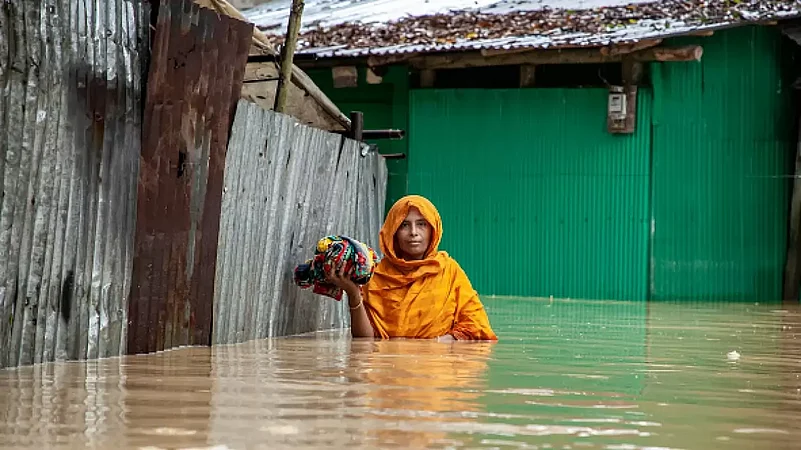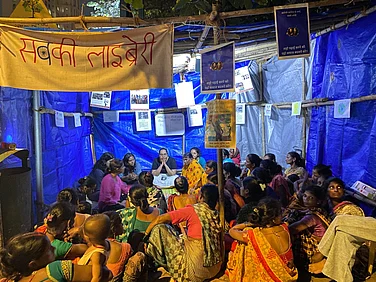"Where do we go now? 25 years ago I lost my home and came to this city for livelihood. I came to this city empty-handed and started a new life. This city has sustained us for a long time... But now the city is kicking us out!"
These words were spoken by Rokeya Begum, an old resident of Chittagong's Vera Market. This family has been living in this area for about 25 years. Tidal water from Karnaphuli River quickly enters Vera Market Colony. It was noon. Tidewater in the house of Rokeya Begum, 55, before she finishes cooking. Rokeya tries to finish cooking before the tide rises. But sometimes she is defeated by tidal water. Before the cooking is finished, the water rises in the room.
During high tide, the houses of Chittagong's Vera Market can be seen submerged in water. Everyone's work is off. Some people are stuck indoors. No work can be done until the tide recedes. Rokeya Begum and other families in the colony are worried about their future. Every year monsoon brings extreme misery to the people of Chittagong and people living on the fringes of the city face more problems. Rokeya Begum belongs to such a family. This woman has to face the extreme crisis with 5 members.
Standing in front of the colony house, Rokeya Begum was recalling the day her own house was swept away by a 5-meter-high tidal wave. The cyclone of 29 April 1991 was one of the major cyclones that swept over the coast of Bangladesh. At that time, Rokeya Begum's house was on the banks of the Meghna River in Daulatkhan Upazila of Bhola, an island district on the coast of Bangladesh. She has battled natural calamities for a large part of his life there. Rokeya Begum took refuge in this Vera Market Colony in Chittagong, 104 km from her lost home. But in this city too, this woman has to worry about safe living. The entire colony is submerged in tidal water.
Not only the Vera Market Colony but more than half of Chittagong is flooded with tidal water. According to a survey by the Public Works Directorate, a government institution of Bangladesh, about 69 per cent of the area of Chittagong is now more or less submerged in tidal water. According to another study, about 18 per cent of the city's area is worse off due to tidal water. Flood-affected residents of the city said the inundated area is increasing every year.
The coastal city of Chittagong is sinking fast
The results of the survey published in Geophysical Research Letters are very similar to this picture of the latest high tide in Chittagong. According to the study, the second-largest city in Bangladesh lost 2.39 centimeters of land each year between 2015 and 2020; This increased the likelihood of flooding nearly seven times faster than the average sea-level rise. Bangladesh's Chittagong and other Asian coastal cities are sinking faster than the rate of sea level rise, the study said. The ten fastest-sinking cities in the world are — Tianjin (China), Semarang (Indonesia), Jakarta (Indonesia), Shanghai (China), Ho Chi Minh City (Vietnam), Hanoi (Vietnam), Chittagong (Bangladesh), Kobe ( Japan), Kerala (India) and Houston (USA).
Coastal cities in South and Southeast Asia are sinking fast, according to a study published in the journal Nature Sustainability. Poorly controlled urbanisation is the cause. Scientists say rising sea levels are already increasing the risk. Over the past two decades, the population of Chittagong, Bangladesh, near the Bay of Bengal, has grown by more than 120 per cent to 5.2 million. It is one of the fastest-sinking cities in the world, according to new research.
According to the Intergovernmental Panel on Climate Change (IPCC), the sea level has been rising at a rate of about three millimetres per year since 1993.
Climate migrants face new climate risks
High tide days change the daily schedule of everyone in this colony, including Rokeya Begum. They have to complete all the work before the tidal water enters the house. During high tide (4-5 hours) everyone has to stay indoors. Vera Market Colony is in Ward No. 35 of Chittagong. Karnaphuli River flows near the colony. The sea is only 16 km away from this point of the river. Tidal water from the sea enters the canals of the city through the Karnaphuli River. As a result, different areas of the city were flooded. When the monsoon comes, the crisis of these people increases. As it has increased this year.
Just like Rokeya Begum, many more climate migrants come to Chittagong and face new climate risks. Millions of people came to Chittagong city in the last few decades from different areas of the coast of Bangladesh for the need of livelihood. Most of them have lost all their properties including houses due to cyclones, river erosion or floods. They considered the commercial city of Chittagong a safe place to live and earn. But here too they have to face natural calamities. Over the past few years, many families in this city have been forced to change their place of residence time and again. Many families are living in high-rise areas of the city during monsoons with high house rents. At the end of monsoon season, they again move to low-rent houses in the low-lying areas of the city.
Mohammad Shahjahan, 60, works as a labourer in Chittagong. He came to this city in search of work when he was only 20 years old. His home was in Dakshin Syedpur village of Bhola district on the coast. Shah Jahan saw his father lose all his property in his childhood. Their house had to be shifted seven times due to Meghna River erosion. The site of Shahjahan's father's house had long since moved to the middle of the Meghna River. Both Shah Jahan and his father considered the city of Chittagong as a safe city for livelihood. But now Shah Jahan worries about whether he can live in this city.
It can be seen around the ground that tidal water has risen on the roads and houses of the Tulatali area of Ward No. 19 of Chittagong. People are stuck indoors or on elevated roads. Many were moving through the water for emergency purposes. Roads in these areas were raised three feet due to rising tidal water. But there is still two feet of water above the road at high tide.
Cities need to be climate-resilient
Dr Salimul Haque, director of The International Center for Climate Change and Development (ICCCAD) and an international climate expert, said, ‘In my view, one of the most vulnerable groups of people suffering impacts of climate change are those who have had to evacuate and move multiple times due to climate change impacts. planning should be done keeping in mind the issue of safe living of climate-vulnerable migrants in urban areas.’
Mr Shamsuddoha, Chief Executive of Center for Participatory Research and Development (CPRD), said, ‘Involuntary migration from the climate risk-exposed coastal areas to the urban areas is now a common phenomenon. People are failing to adapt to the increased Climatic stresses that are affecting their daily lives and living. In many areas, people are failing to adapt to the repeated and multiple climate-induced disasters and their residual impacts extended to secondary and tertiary risk levels.’
He said, ‘Migrations are not planned. Migration is a consequence of adaptation failure and a strategy for saving lives from multiple risks. Such a strive to escape risk has not been a concern of city governments and governance. Most major cities of Bangladesh, such as Chittagong, Dhaka, Khulna, Barisal are not climate resilient. Unsustainable development works, destruction of natural ecosystems, unplanned infrastructure etc made Cities more vulnerable to climate change impacts. It is understandable that cities with their increasing fragility to the Climatic risks will not be able to secure people's lives from the climate impacts.’
‘We cannot stop people moving from climate-prone areas to big cities. Therefore, cities need to plan long-term to protect climate migrants from risks. Initiatives should also be taken to assist them with improved livelihoods and basic services,’ said Md Samsuddoha.
Khairul Alam Sujan, an old resident of Chittagong's Agrabad commercial area, is worried about living and doing business in the city. He said, ‘I was born in this city. As children, we never saw water in the city. After 1992-93 water started entering the city. The Chittagong Development Authority or CDA area was once known as the elite area of the city. Many people came and settled in that area. Now the residents of that area are moving elsewhere. The entire area is submerged during high tide. The ground floor of many houses has been abandoned. If you want to live in this city, you have to take development projects to adapt to climate change.’





















